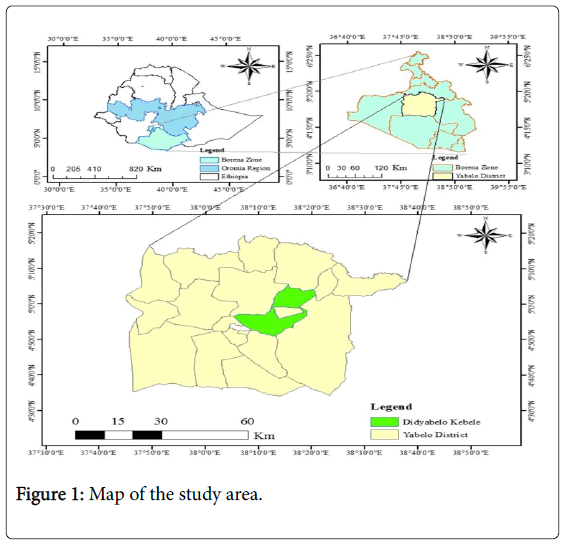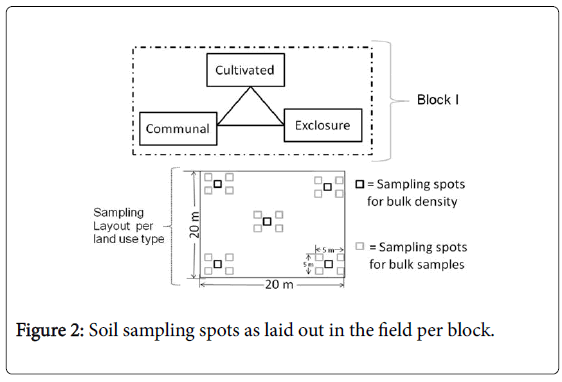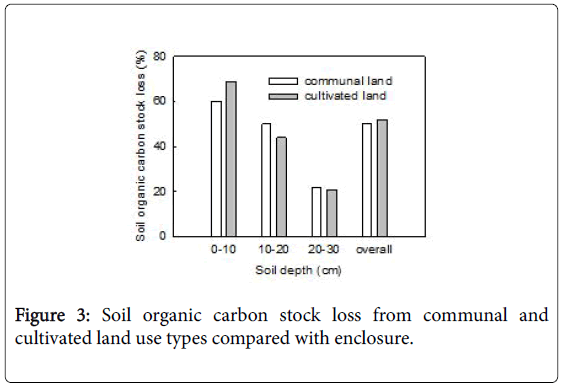Journal of Agricultural Science and Food Research
Open Access
ISSN: 2593-9173
ISSN: 2593-9173
Research Article - (2019)Volume 10, Issue 1
Understanding the impact of land use change on soil organic carbon stock following the conversion of a semiarid rangeland into different land use types is essential to devise an appropriate and sustainable rangeland management strategy. However, there is a knowledge gap as to the impact of currently ongoing land use changes on soil organic carbon stock, which is an important rangeland ecosystem service, particularly in the face of climate change. Thus, this study was conducted to assess the effect of land use change on soil organic carbon stock in three land use types, namely, enclosures, communal grazing and cultivated lands in Borana rangeland. The result indicated that there were significant interactions between land use types and depths for soil organic carbon stock (p<0.0001) and bulk density (p=0.0055) with mean losses of 60% and 69% in soil organic carbon stock from the surface layer (0-10 cm) of communal and cultivated lands, respectively, as compared to enclosure land use type. The results indicated that communal grazing and crop cultivation in the Borana rangeland resulted in significantly decreased soil organic carbon stock. Hence, the current trend must be curbed to put back the system on its right track of resilience and sustainability for its long-term benefit and to mitigate the unprecedented increase in CO2. Therefore, the results of this study would be useful for the improvement of land use management in the future.
Soil organic carbon; Land use change; Rangeland; Ethiopia; Climate change
Land use changes such as conversion of grasslands to croplands significantly contribute to elevated atmospheric CO2 concentrations, although the primary anthropogenic source of CO2 in the atmosphere is the combustion of fossil fuel use [1,2]. Conversion of native rangeland into crop cultivation has a tremendous effect on soil organic carbon in dry land ecosystem [3,4]. Cultivated areas experience degradation due to human and livestock population increases which reduce the soil organic matter owing to the low level of plant residues and increased erosion losses [5]. A study by Yimer et al. showed that significant changes in soil organic matter occurred after conversion of natural vegetation to overgrazed and cultivated lands [6]. Crop cultivation in former grassland is one of the major threats to rangelands today, both for traditional pastoralists as well as in terms of carbon emission, because it breaks up soil aggregates, which opens up previously unavailable carbon compounds for decomposers access leading to giving off of carbon stock [4,7].
Herbivory removes above-ground biomass and changes the below-ground biomass and, hence, soil organic carbon stocks in rangelands [8]. Carbon storage decreases and barely recovers under heavy grazing [9].
Despite the established scientific knowledge of effects of crop cultivation in dryland ecosystem, some still recommend crop cultivation than animal production for the semiarid Borana rangeland, particularly, as a feasible livelihood activity in the face of climate change [4,7,10]. Up till now, there were few scientific knowledge of soil organic carbon under different land use types though they did not specifically address the impact of currently expanding crop cultivation on soil organic carbon of the semiarid Borana rangeland [11,12]. In other word, studies on impacts of expanding crop cultivation on the soil organic carbon stock in the semiarid Borana rangeland is still lacking. Hence, this knowledge gap urgently needs to be filled through research in order to inform policy makers about impacts of land-use change, which has been expanding for decades, so that appropriate strategy for a sustainable use of the rangeland resources in the face of climate change would be devised [13,14]. Therefore, the objective of this study was to assess the effects of conversion of rangelands into different land use types on soil organic carbon stock in Yabello area of Borana rangeland, Ethiopia.
Study area
The study was conducted in Yabello district, Southern Ethiopia, which is located in the hub of Borana rangeland, 570 km south of Addis Ababa; its altitude varies from 1000 to 1500 m.a.s.l with picks that range up to 2000 m.a.s.l (Figure 1) [15]. It has bimodal rainfall that ranges from 400 mm in the southeast to 600 mm in the north with high altitudinal variability [16]. Mean annual temperature varies from 19°C to 24°C. The soil types of the study area are Chromic Luvisols [15].

Figure 1: Map of the study area.
Soil sampling and laboratory analysis
We purposively selected three land use types (communal grazing, cultivated and enclosure) by considering fertile bottomlands where expansion of crop cultivation is severe in a sandy clay loam soil [17]. The area selected for communal grazing land use type was a rangeland site with no history of either cultivation or enclosure, while the cultivated and enclosures were areas adjacent to the communal grazing sites with the same soil characteristics, but under cultivation and enclosure, respectively, for a minimum of 10 years each. We laid out the sampling plots in four blocks, each containing the three land use types (Figure 2). The soil sampling spots were arranged in each land use type as shown in Figure 2. We collected soil samples from each land use type of 5 m × 5 m plots, which were laid out within 20 m × 20 m at each four corners and center to capture the heterogeneity in soil fertility of the rangeland (Figure 2); and we composited the sampling spots within 20 m × 20 m to form a sample at each soil depth layers (0 - 10 cm, 10 - 20 cm, 20 - 30 cm), which was taken to a depth of 30 cm [18,19].

Figure 2: Soil sampling spots as laid out in the field per block.
A total of 36 sampling plots (3 land uses types × 4 blocks × 3 soil depths) were laid out for soil sampling. Additionally, we collected 36 independent soil samples with core sampler for the determination of the soil bulk density. The soil bulk density was collected from five spots within 20 m × 20 m plot and then averaged per depth for later use in soil organic carbon stock calculations (Figure 2). Collected soil samples were dried at a constant room temperature and sieved (2 mm) to eliminate coarse soil particles before analyses. The bulk density was calculated by dividing the mass of oven dried soil (g) by volume of bulk soil (cm3) [20]. The soil organic carbon was determined according to the Walkley and Black method [21]. The result of the analyses was converted into soil organic carbon stock based on the basic equation [22].
Where, SOCS=soil organic carbon stock (g/cm3),
SOC=soil organic carbon concentration (%),
BD=bulk density (g/cm3),
Depth=soil depth (cm).
Then, the values of SOCS were converted to carbon in tons per hectare after multiplying by 100 t/ha.
Statistical analysis
We analyzed the data by two-way analysis of variance (ANOVA), using factorial blocked design with land use type and soil depth as independent factors, in the general linear model (GLM) procedure [23]. The Tukey test was used for mean separations at alpha=0.05.
Effects of land use on soil organic carbon
There were significant interactions between land use types and depths in soil organic carbon stock. The soil organic carbon stock values were significantly higher in the top soil surface layer of enclosure compared to other land use types and were significantly lower in the subsurface of communal land use type (Table 1).
| Source of variation | df | SOCS | BD | ||
|---|---|---|---|---|---|
| MS | p | MS | p | ||
| Land use (LU) | 2 | 141.56 | <0.0001 | 0.001 | 0.6105 |
| Depth (D) | 2 | 59.66 | <0.0001 | 0.008 | 0.0351 |
| LU*D | 4 | 37.21 | <0.0001 | 0.01 | 0.0055 |
| Error | 24 | 1.75 | 0.002 | ||
Table 1: Summary of two-way ANOVA for soil bulk density (BD) and soil organic carbon stock (SOCS) in relation to land use types and soil depths.
Effects of land use on bulk density
There were significant interactions between land use types and soil depths in bulk density (BD). The bulk density of the surface soil under the enclosure land use type was lower as compared to communal land use types, but it was not significantly different from cultivated land (Table 2).
| Variables | Depth | Land use | Overall | ||
|---|---|---|---|---|---|
| Communal | Cultivated | Exclosure | |||
| SOCS | 0-10 | 718Aa ± 124 | 564Aa ± 76 | 1810Bb ± 239 | 1031 ± 598 |
| 44105 | 479Ab ± 127 | 535Aa ± 49 | 963Bc ± 163 | 659 ± 251 | |
| 20-30 | 574Ab ± 85 | 584Aa ± 86 | 737Aa ± 60 | 632 ± 105 | |
| Overall | 591 ± 149 | 561 ± 68 | 1170 ± 507 | ||
| BD | 0-10 | 1.20Aa ± 0.034 | 1.16ABa ± 0.02 | 1.12Ba ± 0.013 | 1.16 ± 0.04 |
| 44105 | 1.06Ab ± 0.07 | 1.13Ba ± 0.04 | 1.14Ba ± 0.015 | 1.11 ± 0.06 | |
| 20-30 | 1.13Ac ± 0.067 | 1.06Bb ± 0.042 | 1.15Aa ± 0.055 | 1.11 ± 0.06 | |
| Overall | 1.13 ± 0.08 | 1.13 ± 0.05 | 1.11 ± 0.03 | ||
Note: Means in the same column and row followed by the same lowercase uppercase letters, respectively, are not significantly different at α=5%.
Table 2: Mean ( ± SD) of soil bulk density (BD, g/cm3) and soil organic carbon stock (SOCS, t/ha) as influenced by land use type and soil depth.
Soil organic carbon loss due to overgrazing and crop cultivation
There was a significant amount of soil organic carbon loss due to overgrazing and crop cultivation (Figure 3). The result of soil organic carbon from communal and cultivated land has resulted in a tremendous loss particularly from the surface layers compared to results from enclosure land use type at all depths, albeit both land use forms resulted in the overall loss of half of the soil organic carbon stock compared to enclosure (Figure 3).

Figure 3: Soil organic carbon stock loss from communal and cultivated land use types compared with enclosure.
Effects of land use on soil organic carbon
Our result indicated that soils under enclosure land use type had a significantly higher soil organic carbon stock in the surface soil than those in communal and cultivated land use types. This higher soil organic carbon stock might be attributable to increased input from fresh material decomposition of some parts of above ground foliage, which is the main pathway of input of new soil organic carbon into the soil; i.e., input from material decomposition was relatively lower in communal and cultivated land use types owing to removal by grazing animals and the farmers [24,25]. Further, the interactions between detrital input and mineralization facilitated by soil microorganisms and low disturbance of soil led to high soil organic carbon [24,25].
It is estimated that globally more carbon is potentially stored in grasslands than in forests, and grasslands continuously sequester carbon [26]. Grasses have also been found to contribute more than legumes to soil carbon stocks and to sequester similar amounts of soil carbon compared to native forests in subtropical climate or even woodlands in comparable semi-arid climate [27-29]. However, the encroachment of cropping activities into grasslands significantly reduces this grass carbon storage capacity while the reversal of land use from cropland (tree plantations) to grassland was found to enhance soil organic carbon sequestration in a semi-arid area [30,31].
Overall, half of the soil organic carbon stocks were lost from communal and cultivated land as compared to enclosure land use type. This loss in soil organic carbon stock recorded in the communal and cultivated land use types could mainly be attributed to the high level of soil disturbance, caused by the removal of vegetation cover due to overgrazing and tillage activities, respectively, which led to the low amount of fresh organic materials returned to the soil with high rates of oxidation of soil organic matter due to soil disturbance and tillage practice [6,7]. Similar to other dryland systems, where nearly 50% of carbon stock was lost due to crop cultivation that may take up to 100 years to restore the lost carbon, the semiarid Borana rangeland lost 52% overall soil organic carbon due to crop cultivation compared with enclosure land use type. Restoring the lost carbon requires more years for the plant biomass to be converted into soil organic carbon [7,32]. Hence, long-term improvements in soil carbon stocks can be only expected after several years and will contribute to significant long-term carbon storage in rangelands under grazing [33]. Further, higher soil organic carbon can, in turn, lead to higher above- and belowground organic carbon of plants [34]. Conversely, removal of crop residue from cultivated land use type and the removal of grass vegetation due to overgrazing contributed to the low soil organic carbon stock [35,36]. Soil compaction due to overgrazing increased bulk density, which might facilitate the further loss of soil organic carbon by runoff [35]. As compared to cultivated land use type, the communal land use types relatively have higher soil organic carbon in the surface soil because the disturbance from tillage activities, in the cultivated land, led to rapid loss of soil organic carbon in the upper soil layer increasing its decomposition by microorganisms [7].
Similar to many of global rangelands, Borana rangeland has been degrading, which means that rangelands might have the greatest potential to sequester more carbon if properly managed. Proper management of the dryland facilitates the process of sequestering carbon that mitigates CO2 emissions [37-39]. Any management aimed at increasing in carbon sequestration should be of paramount importance in the face of climate change [40]. Such suitable management practices can increase the considerable amount of carbon stocks or decreases in carbon losses [41].
Effects of land use on soil bulk density
Soil under enclosure land use type had significantly lower soil bulk density than communal land use type. This is attributable to the high addition of soil organic matter to the soil surface by roots and shoots of enclosure grasses, which increased soil organic carbon and hence decreased soil bulk density of the surface soil as reported by previous studies [25,42]. Additionally, the small soil disturbance and the slow humification and mineralization of the organic materials through the addition of above and below ground biomass also might contributed to lower bulk density [43]. With regard to the cultivated lands, the soil bulk density on the surface soil was slightly higher as compared to the enclosure land use type. This might be attributed to soil disturbance resulting from farming practice which has resulted in the relatively higher bulk density due to loss of soil organic carbon in surface soil. Additionally, mechanical breakdown of soil aggregates and loss of aggregate-protected soil organic carbon exposed to lose due to microbial activities [7]. Moreover, soils under communal grazing land showed a higher bulk density in the surface layer (0-10 cm) as compared to the enclosure and cultivated land use types. This might be attributed to high level of disturbance and compaction due to livestock overgrazing that led to rangeland degradation in the area [44].
The results from our study showed variations in the organic carbon stock and bulk density across land uses types and soil depths. Generally, the higher soil organic carbon stock in enclosure land use type might be attributed to the higher accumulation of organic matter, which, in turn, was caused by higher above and below ground biomass and reduced litter decomposition rates. The lower bulk density in enclosure land use type is a result of fewer disturbances, higher litter fall, and organic matter accumulation which indicated better management that led to better soil organic carbon sequestration. Unfortunately, the recent recommendations of crop cultivation as a coping mechanism in the face of climate change, hence, would further reduce the carbon sequestering potential of the rangeland. Further, the livestock population causing degradation must be reduced to balance with the ecological potential of the area through facilitating animal sales. Therefore, the current trend must be curbed to put back the system on the right track to the resilient environment for sustainable rangeland ecosystem service. Generally, overgrazed communal and cultivated lands need to be managed appropriately through the application of different techniques, such as reducing overgrazing and crop cultivation and restoring degraded areas to enhance the carbon sequestration potential of the rangelands as CO2 emission mitigation options in the face of climate change.
Citation: Shiferaw A, Yimer F, Tuffa S. Changes in Soil Organic Carbon Stock Under Different Land Use Types in Semiarid Borana Rangelands: Implications for CO2 Emission Mitigation in the Rangelands. J Agri Sci Food Res. 2019;9:254. doi: 10.35248/2593-9173.19.10.254
Received: 28-Jul-2018 Accepted: 10-Dec-2018 Published: 10-Jan-2019 , DOI: 10.35248/2593-9173.19.10.254
Copyright: © 2019 Shiferaw A, et al. This is an open-access article distributed under the terms of the Creative Commons Attribution License, which permits unrestricted use, distribution, and reproduction in any medium, provided the original author and source are credited.